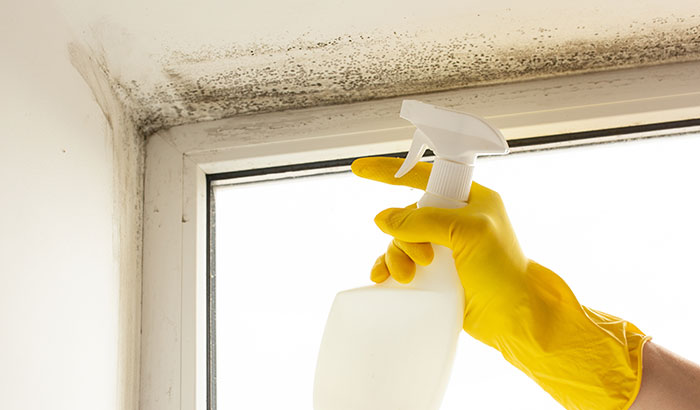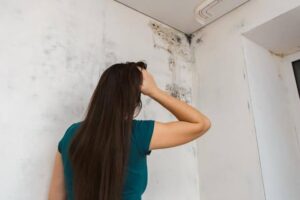When it comes to mold prevention, there are so many questions: What is mold? How do I prevent mold? How can I rid my home of mold damage? In this article, we are going to answer all these questions.
What is Mold?
Mold is a type of fungus that grows in damp and humid environments, both indoors and outdoors. It reproduces through spores released into the air and can settle on surfaces, where they can grow into new mold colonies.
Mold needs moisture to grow, so it is often found in damp or humid areas, such as bathrooms, kitchens, and basements. It can grow on various surfaces, including walls, ceilings, floors, carpets, and furniture.
Mold can be difficult to detect and sometimes grow in hidden areas, such as inside walls or behind appliances. It is important to address any moisture issues and properly clean and remove mold growth to prevent its spread and potential health effects.
Pretty intimidating right? When it comes to mold, the best thing to do is to be diligent about preventing mold growth altogether. But how?
Here are 20 ways to prevent mold growth in your home:
- Keep Humidity Levels Low: Ideally, indoor humidity levels should be between 30-50%. You can use a dehumidifier to maintain appropriate levels.
- Use Exhaust Fans: In the bathroom and kitchen, use exhaust fans to remove excess moisture from the air.
- Fix Leaks: Address any leaks in pipes, faucets, or roofs as soon as you notice them.
- Clean Up Spills and Standing Water: Dry any spills or standing water immediately to prevent mold growth.
- Improve Ventilation: Increase air circulation throughout the home by opening windows or using a fan.
- Use Mold-resistant Products: Choose mold-resistant paint, drywall, and insulation for moisture-prone areas.
- Clean and Maintain Air Conditioning and Heating Systems: Regularly clean and maintain your HVAC system to prevent mold growth in the ductwork.
- Use Mold-killing Products: Use cleaning products specifically designed to kill and prevent mold growth.
- Don’t Carpet Bathrooms or Basements: Carpeting in moisture-prone areas can be a breeding ground for mold.
- Keep Indoor Plants to a Minimum: Indoor plants can increase humidity levels, so limit the number of plants in your home.
- Use a Sump Pump: If your basement is prone to flooding, consider installing a sump pump to remove excess water.
- Use an Air Purifier: An air purifier with a HEPA filter can remove mold spores.
- Inspect and Clean Gutters: Clogged gutters can cause water to back up and seep into your home, creating conditions favorable for mold growth.
- Keep Clothes Dry: Ensure clothes are completely dry before storing them in closets or drawers.
- Seal Windows and Doors: Properly seal windows and doors to prevent moisture from seeping in.
- Use a Moisture Meter: A moisture meter can help you detect moisture levels in different areas of your home and identify potential problem areas.
- Use a HEPA Vacuum: A vacuum with a HEPA filter can help remove mold spores and other allergens from your home.
- Use a Hygrometer: A hygrometer can measure humidity levels in your home so you can maintain appropriate levels.
- Clean and Dry Bath Mats: Clean and dry bath mats regularly to prevent moisture from accumulating underneath.
- Store Items Properly: Store items prone to mold growth, such as books and clothing, in dry, well-ventilated areas.
If you’ve done all the right things to prevent mold growth and you still, unfortunately, find mold creeping around your home, here are the steps you should take:
- Identify the Source of Moisture – Mold typically grows in areas with high humidity or moisture, so you should try to identify and address the source of moisture causing mold growth.
- Isolate the Area – If possible, close doors and windows to prevent the spread of mold spores to other areas of your home.
- Wear Protective Gear – Wear protective gear, such as gloves, goggles, and a mask, to protect yourself from exposure to mold spores.
- Clean up the Mold – Small amounts of mold can be cleaned using water and detergent. You may need to hire a professional mold remediation company for more significant amounts of mold or if the mold has spread to hidden areas.
- Remove Affected Materials – Porous materials affected by mold, such as carpet or drywall, may need to be removed and replaced to prevent further mold growth.
- Dry the Area – After cleaning up the mold, thoroughly dry the affected area to prevent mold growth.
- Monitor for Mold Growth – Keep an eye on the area where the mold was found and check for any signs of new mold growth.
It’s important to note that some types of mold can be dangerous to your health, especially if you have a weakened immune system or respiratory issues. If you’re not sure how to safely and effectively clean up the mold, or if you have any health concerns, it’s best to consult a professional.
Mold damage cleanup should be left to professionals for several reasons:
- Health Risks – Certain types of mold, such as black mold, can be toxic and pose a health risk to those exposed to it. Professional mold remediation companies have the training, expertise, and equipment to safely and effectively remove mold and prevent its spread.
- Hidden Mold – Mold can grow in hidden areas, such as inside walls or behind cabinets, and it can be difficult to detect and remove without the proper equipment and training. Professionals have the tools and knowledge to detect and remediate hidden mold.
- Prevention of Further Damage – If mold is not properly and completely removed, it can continue to grow and spread, causing further damage to your home and potentially affecting your health. Professionals can effectively remove all mold and take steps to prevent its future growth.
- Insurance Coverage – Some insurance policies may require that mold remediation be performed by a professional.
- Avoiding DIY Mistakes – Removing mold on your own can sometimes worsen the problem. For example, using bleach to clean mold can actually make it worse by releasing mold spores into the air. Professionals have the knowledge and expertise to safely and effectively remove mold.
To ensure that the mold is completely and safely removed and to protect your health and prevent further damage to your home, it is time to call the professionals — specifically the professionals at Total Flood & Fire Restoration.
Our team of experts is ready and available to identify the mold’s source, eliminate it safely, effectively prevent future mold growth, and get your home and belongings back to their best condition.
If you suspect mold is present in your home, contact us today!







